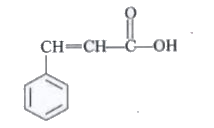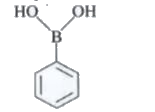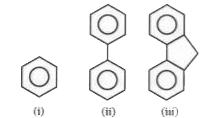Electrophilic aromatic substitution is difficult in
p−NH2C6H4CO2H
p−CH3OC6H4CO2H
P−NO2−C6H4CO2H
p−ClC6H4CO2H
The correct Answer is:C
To solve the question regarding which molecule makes electrophilic aromatic substitution difficult, we need to analyze the given compounds based on their substituents and their effects on the benzene ring.
1. Identify the Common Structure:
All the compounds have a common structure of a benzene ring (C6H4) and a carboxylic acid group (COOH).
2. List the Substituents:
We need to look at the substituents attached to the benzene ring in each compound:
- Compound 1: NH2 (amino group) at the para position.
- Compound 2: OCH3 (methoxy group) at the para position.
- Compound 3: NO2 (nitro group) at the para position.
- Compound 4: Cl (chloro group) at the para position.
3. Determine the Effect of Each Substituent:
- NH2 (Amino Group): This group has a +R (resonance donating) effect, which increases the electron density in the benzene ring, making electrophilic substitution easier.
- OCH3 (Methoxy Group): Similar to the amino group, the methoxy group also has a +R effect, increasing electron density and facilitating electrophilic substitution.
- NO2 (Nitro Group): This group has a -R (resonance withdrawing) effect, which decreases the electron density in the benzene ring, making electrophilic substitution difficult.
- Cl (Chloro Group): The chloro group has a -I (inductive withdrawing) effect, which also decreases electron density but is less effective than the -R effect of the nitro group.
4. Conclusion:
Since the nitro group (NO2) is a strong electron-withdrawing group, it significantly decreases the electron density of the benzene ring. This makes electrophilic aromatic substitution very difficult in the presence of the nitro group compared to the other substituents.
5. Final Answer:
The compound where electrophilic aromatic substitution is most difficult is para-nitrobenzoic acid (option C).
All the compounds have a common structure of a benzene ring (C6H4) and a carboxylic acid group (COOH).
We need to look at the substituents attached to the benzene ring in each compound:
- Compound 1: NH2 (amino group) at the para position.
- Compound 2: OCH3 (methoxy group) at the para position.
- Compound 3: NO2 (nitro group) at the para position.
- Compound 4: Cl (chloro group) at the para position.
- NH2 (Amino Group): This group has a +R (resonance donating) effect, which increases the electron density in the benzene ring, making electrophilic substitution easier.
- OCH3 (Methoxy Group): Similar to the amino group, the methoxy group also has a +R effect, increasing electron density and facilitating electrophilic substitution.
- NO2 (Nitro Group): This group has a -R (resonance withdrawing) effect, which decreases the electron density in the benzene ring, making electrophilic substitution difficult.
- Cl (Chloro Group): The chloro group has a -I (inductive withdrawing) effect, which also decreases electron density but is less effective than the -R effect of the nitro group.
Since the nitro group (NO2) is a strong electron-withdrawing group, it significantly decreases the electron density of the benzene ring. This makes electrophilic aromatic substitution very difficult in the presence of the nitro group compared to the other substituents.
The compound where electrophilic aromatic substitution is most difficult is para-nitrobenzoic acid (option C).
Similar Questions
Knowledge Check

Decreasing order of rate of electrophilic aromatic substitution is : (Aa gt b gt c gt dBa gt c gt b gt dCb gt a gt c gt dDb gt c gt a gt dWhich of the following are more reactive than diphenyl in electrophilic aromatic substitution reaction ?
A B
B C
C D
D
Which of the following are deactivating but ortho, para directing during electrophilic aromatic substitution reaction ?
A B
B C
C D
D
Which of the following species is expected to have maximum enthalpy in an electrophilic aromatic substitution reaction ?

View Solution_2019_CBT5_E01_008_Q01.png)
The correct rate of reaction of given compounds towards electrophilic aromatic substitution reaction is
View SolutionRank the following compounds in decreasing order of reactivity in electrophilic aromatic substitution reaction

View SolutionHow many of the following are activated towards electrophilic aromatic substitution reactions?

View SolutionArrange in their decreasing order of rate of electrophilic aromatic substitution :

View Solution

